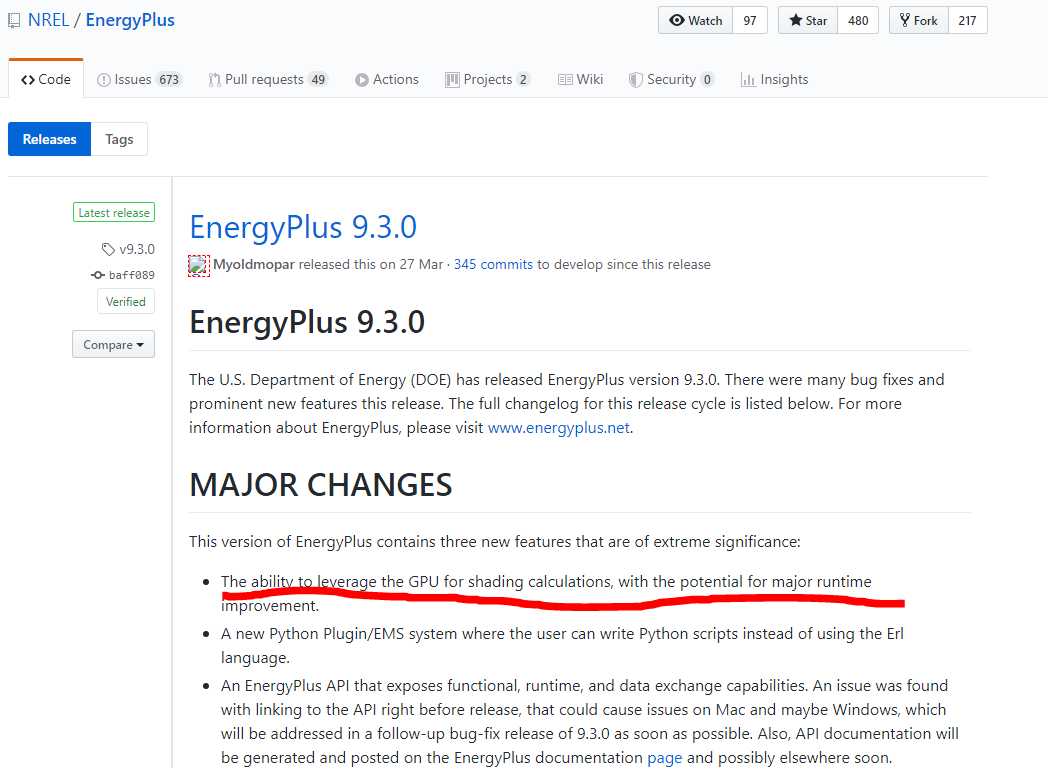How can this be implemented in honeybee?
These are all very interesting features. Is there any documentation for this new feature?
I’m also very excited to check the Python plugin for EMS. That should make things much easier for us.
cc: @chris, @MingboPeng
Interesting stuff. The GPU calculation documentation is here under the InputOutput reference:
https://bigladdersoftware.com/epx/docs/9-3/input-output-reference/group-simulation-parameters.html#inputs-10-019
It looks like the whole ShadowCalculation object got an overhaul in E+ 9.3, which is likely to break some things in honeybee. It also seems like this GPU method is slower but it gives users a means to run detailed indoor solar distribution without needing to worry about concave zones (something I know a lot of people on this forum will be happy about).
The best I can offer until we upgrade honeybee is to write out an IDF, upgrade it to 9.3 by opening it in the IDFEditor, manually change the ShadowCalculation object, save it, and use the Rerun IDF component to run the model through E+ and import results to Grasshopper.
Once we upgrade honeybee, you’ll be able to do this all in a more streamlined manner like by using a OpenStudio Measure.
Hi Chris, me and another user are having a problem while following your Honeybee YouTube tutorials which I think is related to the EP v9.0 and EP v9.3 issue.
-Honeybee seems to be recognising only Energyplus v9.0 even if EP v9.3 is installed. The output from the Honeybee_Honeybee(Honeybee) component says that it found EP v9.0 even if EPv9.3 is installed.
-Therefore it writes only v9.0 IDF files, which Energyplus v9.3 does not work with.
My work around was to download EP v9.0 and run the simulation manually in Energyplus, and then reimport the result into grasshopper.
Here is the original thread.
Thanks a lot for these brilliant tools and tutorials!
Thanks @Ashwin_A ,
I think the reality of the situation will be that any way of doing this in the legacy honeybee version is bound to be hacky. The IDF component doesn’t support certain features (eg. dynamic shades) in versions of EnergyPlus 9.0 and greater but I am willing to change the code to let honeybee find the higher versions of E+ so that you can at least experiment with the PixelCounting GPU feature if you don’t have dynamic shades in your model. Normally, I would recommend using OpenStudio to work with EnergyPlus if you want to use versions of E+ higher than 8.9 but I have found that OpenStudio 3.0 (using E+ 9.3) suffers from the infamous PINVOKE error.
The good news is that I have tested the PixelCounting feature with the new [+] version of the plugin that we are close to having an official release of and it works perfectly. It seems that this GPU-based PixelCounting will finally gives us a means of dealing with this CHKBKS issue that you see has plagued this forum a lot.
